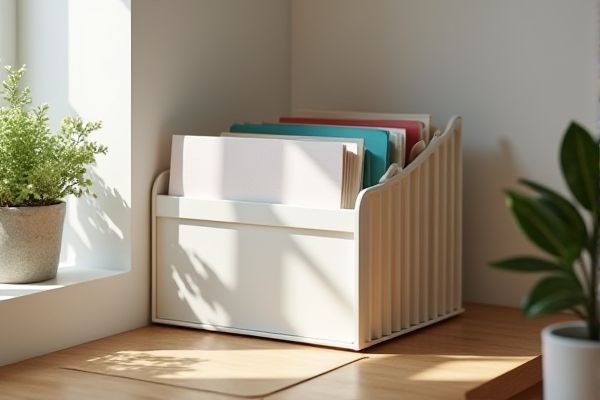
A file organizer efficiently categorizes and stores physical or digital documents for easy access and management, while a mail sorter primarily focuses on sorting incoming and outgoing mail based on recipient or department. Discover how choosing the right tool can streamline Your workflow by reading the full article.
Table of Comparison
| Feature | File Organizer | Mail Sorter |
|---|---|---|
| Primary Function | Manages and organizes digital or physical files and documents | Sorts and categorizes incoming emails automatically |
| Use Case | File management in offices and personal computers | Email management in inboxes for better workflow |
| Key Features | Folder creation, tagging, metadata management, search optimization | Automatic folder routing, spam detection, priority tagging, filters |
| Supported Formats | Documents (PDF, DOCX), images, spreadsheets, etc. | Email formats (IMAP, POP3), attachments |
| Automation Level | Partial to full based on rules and AI | High automation with AI-driven sorting and filtering |
| Integration | Cloud storage platforms, local file systems, enterprise software | Email clients, CRM systems, productivity tools |
| Benefits | Improved file retrieval, reduced clutter, enhanced productivity | Inbox decluttering, faster email response, prioritized communication |
Introduction to File Organizers and Mail Sorters
File organizers streamline document management by categorizing and storing physical or digital files systematically, enhancing retrieval efficiency and workspace organization. Mail sorters automate the distribution of incoming mail by scanning, categorizing, and routing correspondence based on predefined criteria, optimizing postal operations and reducing manual handling. Both tools boost productivity by minimizing clutter and accelerating access to important information in office environments.
Key Functions: File Organizer vs Mail Sorter
File organizers primarily focus on categorizing, storing, and managing digital or physical documents for quick access and efficient retrieval. Mail sorters automate the process of categorizing, directing, and distributing incoming mail based on predefined criteria, often integrating barcode scanning or address recognition. Your choice depends on whether you need systematic document management or streamlined mail processing tailored to organizational needs.
Design Differences Explained
File organizers typically feature stackable trays, compartments, or drawers designed to hold physical documents, with materials ranging from plastic to wood for durability and aesthetics. Mail sorters commonly incorporate labeled sections or slots tailored to categorize incoming mail by recipient or priority, often featuring angled or vertical dividers to optimize space and accessibility. The design of file organizers emphasizes document protection and long-term storage, whereas mail sorters prioritize quick sorting and easy retrieval.
Material Options for Each Organizer
File organizers are commonly made from materials like plastic, metal, wood, and fabric, offering durability and aesthetic variety suitable for desk or office use. Mail sorters often utilize lightweight plastic, wire mesh, or cardboard to facilitate easy sorting and portability while maintaining functionality. Material choice impacts durability, weight, and visual appeal, influencing the effectiveness of either organizer in different workspace environments.
Space-Saving Benefits Compared
File organizers maximize vertical storage, allowing efficient use of desk or office space by stacking documents in compact compartments. Mail sorters typically feature multiple slots for incoming and outgoing correspondence, reducing clutter and preventing paper piles from spreading across surfaces. Both tools enhance spatial efficiency, but file organizers offer more dense storage suitable for archived documents, while mail sorters prioritize quick access to frequently handled mail.
Efficiency in Document Management
File organizers streamline physical document management by categorizing papers into labeled folders, reducing search time and minimizing clutter. Mail sorters automate the segregation of incoming mail based on predefined criteria, enhancing processing speed and accuracy in high-volume environments. Combining both systems optimizes overall efficiency by integrating physical document organization with digital mail handling workflows.
Best Uses: When to Choose File Organizer
A file organizer is ideal for managing physical documents, receipts, and personal paperwork that require easy access and categorization, while a mail sorter is best suited for handling incoming and outgoing mail efficiently. Choose a file organizer when your priority is systematic storage of hard copies to reduce clutter and improve retrieval speed. Your workspace benefits from a file organizer if you deal primarily with paper-based records rather than digital mail management.
Best Uses: When to Choose Mail Sorter
Mail sorter is best chosen when managing high volumes of incoming correspondence requiring categorization by sender, date, or subject for efficient retrieval. It excels in environments like large offices or mailrooms where physical and digital mail needs rapid sorting to streamline distribution processes. Your operations benefit from a mail sorter when prioritizing quick access and systematic organization over the broad file management capabilities of a general file organizer.
Cost Comparison and Value
File organizers generally offer a more cost-effective solution for managing physical documents, often requiring a one-time purchase with minimal maintenance costs. Mail sorters, especially automated or advanced models, come with higher upfront investments and ongoing expenses for operation and maintenance but provide significant value through enhanced efficiency and reduced manual labor. Your choice depends on balancing initial costs against long-term savings and productivity gains in your organizational workflow.
Making the Right Choice for Your Office
Selecting between a file organizer and a mail sorter depends on your office's specific needs for managing physical documents and correspondence efficiently. A file organizer streamlines document storage, ensuring easy access to important papers, while a mail sorter optimizes incoming and outgoing mail distribution to prevent delays. Understanding your workflow and volume of paperwork helps you make the right choice to enhance your office's productivity.
 homyna.com
homyna.com